#Huayan Buddhism
Text
From “The Flower Bank World” in the Avatamsaka Sutra

The Buddhist Painting of Songgwansa Temple, Suncheon, South Korea (Illustration of Avatamsaka Sutra)
“Then Universally Good also said to the assembly, ‘In the land masses of this ocean of worlds are seas of fragrant waters, as numerous as atoms in unspeakably many buddha-fields. All beautiful jewels adorn the floors of those seas; gems of exquisite fragrances adorn their shores. They are meshed with luminous diamonds. Their fragrant waters shine with the colors of all jewels. Flowers of all kinds of gems swirl on their surfaces. Sandalwood powder settles on the bottom of the seas. They emanate the sounds of Buddhas’ speech. They radiate jewellike light. Boundless enlightening beings, holding various canopies, manifest mystic powers causing the adornments of all worlds to appear therein. Stairways of ten kinds of precious substances are set out in rows, with balustrades of ten kinds of jewels surrounding them. White lotuses ornamented with jewels, as many as atoms in four continents, are spread over the waters, in full bloom. There are unspeakable hundreds of thousands of billions of trillions of banners of ten precious elements, banners of belled gauze of raiments of all jewels, as many as sand grains in the Ganges river, jewel flower palaces of boundless forms, as many as sand grains in the Ganges river, a hundred thousand billion trillion lotus castles of ten precious substances, forests of jewel trees as many as atoms in four continents, networks of flaming jewels, as many sandalwood perfumes as grains of sand in the Ganges, and jewels of blazing radiance emitting the sounds of Buddhas’ speech…”
--From book five “The Flower Bank World” in the The Flower Ornament Scripture (Buddhāvataṃsaka Sūtra), translated from Chinese by Thomas Cleary. The various sutras were originally composed in Sanskrit and compiled and translated into Chinese in the 5th century CE. Thomas Cleary’s English translation is based on the Chinese translation done by the Khotanese monk Shikshananda (652-710 CE), who translated it at the request of the Tang Empress.
I stumbled upon this sutra in the back of a book that included a ‘glossary of buddhist terms’ while at a Zen meditation retreat. Flower cosmology? That sounds like my shit. Since I didn’t have my phone I wrote the name down on a piece of paper and slipped it into my backpack. It really is as incredible as I imagined it to be.
“Alan Fox has described the sutra's worldview as ‘fractal’, ‘holographic’, and ‘psychedelic’”—yes.
“In the Huayan school, the teaching of interpenetration is depicted through various metaphors, such as Indra's net, a teaching which may have been influenced by the Gandhavyuha chapter's climax scene in Vairocana's Tower. Indra's net is an infinite cosmic net that contains a multifaceted jewel at each vertex, with each jewel being reflected in all of the other jewels, ad infinitum. Thus, each jewel contains the entire net of jewels reflected within.”
#Avataṃsaka Sūtra#Avatamsaka Sutra#flower garland sutra#Hwaeom#Kegon#Huayan Buddhism#Huayan#chan buddhism#Xianshou#water#buddhism#religion#mysticism#Thomas Cleary#literature#philosophy#metaphysics of flowers#The Flower Ornament Scripture#Buddhāvataṃsaka Sūtra#Buddhāvataṃsaka-nāma-mahāvaipulya-sūtra#Sanskrit
65 notes
·
View notes
Video
youtube
"Subject Meets Object"
When the dancer becomes the dance, when the there's no separation between musician, the music, and the instrument, then we're onto something. If there is a cart with wheels, and a driver, and oxen, and they all perform their correct function, then we can fully realize that the cart is a cart. If there are no oxen, or driver, or wheel, or axel, can the cart truly be considered a cart if it isn't performing its function as a cart? It could be a flower pot, or firewood, or just a random collection of indecipherable elements. But when they interpenetration without hindrance, and none of the elements are separate, then a cart is a cart. When correct function is performed, there is no need for thoughts or analysis, no names required, not concepts to be had. It's "just this." Haengdal Citta gave the Dharma talk January 24, 2024.
0 notes
Text
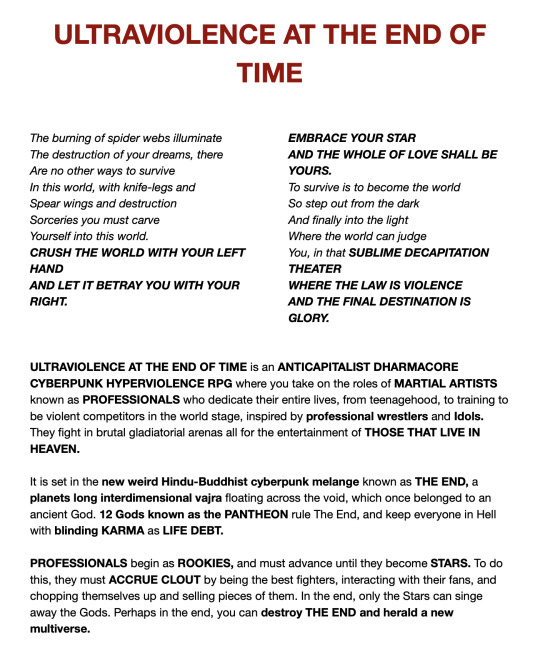
new game idea, building off of gubat banwa's THUNDERING TACTICS SYSTEM. ULTRAVIOLENCE AT THE END OF TIME [UV@TEOT] is very angry and very grungy and its hard distorted electric guitar riffs playing alongside light nujabes flutes and everyone is trying to kill the gods (capitalists)
extreme buddhacore aesthetics mixed with slipstream dirty grungy cyberpunk a la Digital Devil Saga where you play as Black Flame Wielding God Devouring Devil Fucking Martial Artists
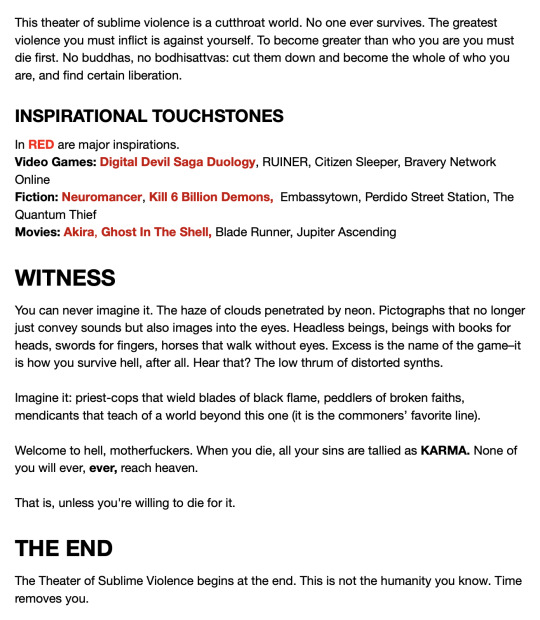
DECAPITATE THE GODHEAD
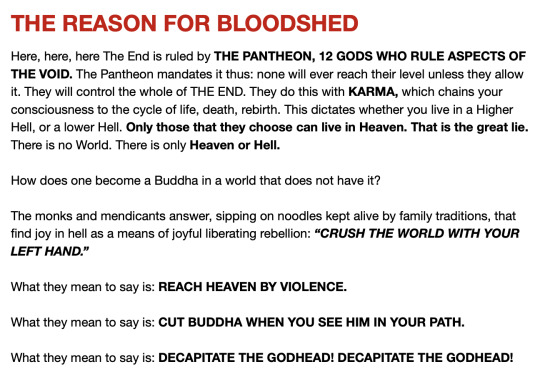
Character Generation is based off an axis of your Zodiac-Tarot (known as KARMIC BURDEN) and MARTIAL COMMUNES (the ones that safeguard your consciousness so you can die multiple times, and also teach you and give you equipment)
Communes are inherently anarchist who steal from HEAVEN to get you equipped. They need Pros like you, so you fight in the grueling gladiatorial matches to get CLOUT, the universal currency. You will never survive without them
character advancement is based on your CLOUT, a la Runes or Souls in Souls-like. its both currency and XP, because you need CLOUT to learn new moves and get new augs. getting new shit is integral to gaining a new following
MARTIAL COMMUNES are slick philosopher-martial art communities that piece together esoteric martial arts. Each commune has a signature martial art that you learn. So far there's THE HEAD OF MARX, TWIN TRUNG ELEPHANTS, SAKAY'S SHADOW FLITTING STYLE, LIVING BODY CANVAS, FLOATING HUAYAN VIDEOMANCY, and THE DIAMOND BODY OF CHRIST-KRISHNA
k6bd is a huge huge inspo of course but unlike k6bd which is a bit more gnostic-buddhist UV@TEOT is more full on Esoteric Vajrayana Buddhism, Shingon Buddhism and an intense Techno-Animism, here's some aesthetic pegs





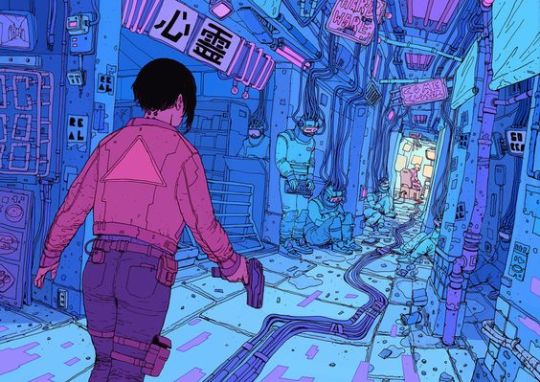

also no playable cops. they're souls chained to physical demons
872 notes
·
View notes
Text
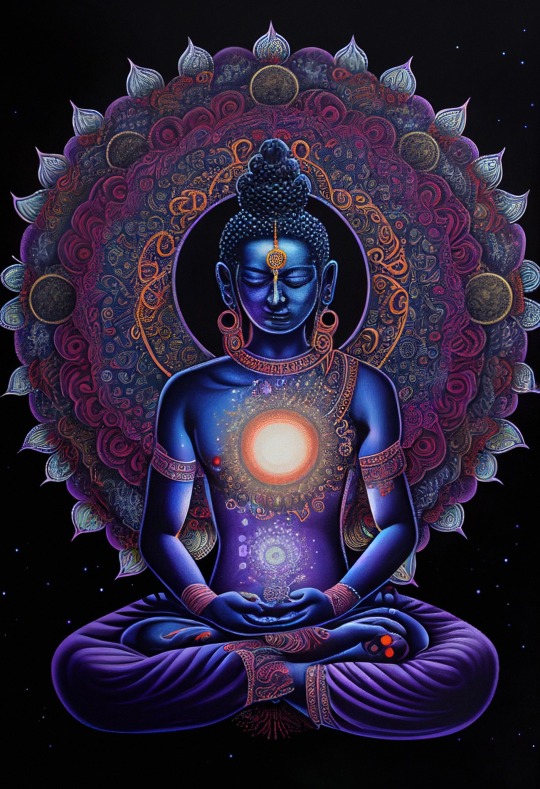
'Cosmic Buddha'
Talon Abraxas
The Avatamsaka Sutra
The Avatamsaka sutra also states that the wisdom of the Buddha (the Tathagata) is present everywhere in the universe, indeed, it is present within every living being. Thus, the sutra states (in chapter 32, Manifestation of the Tathagata): Son of Buddha, the wisdom of Tathagata is present everywhere.
31 notes
·
View notes
Note
So, what IS the Samadhi Fire/True Fire of Samadhi? It can't be an average flame if it can take out Sun Wukong himself in JttW and the name sounds like it means something, but I can't find any context when I look it up.
Journey to the West states that Samādhi fire is not like earthly or heavenly flame. It is something more. Part of a poem in chapter 41 reads:
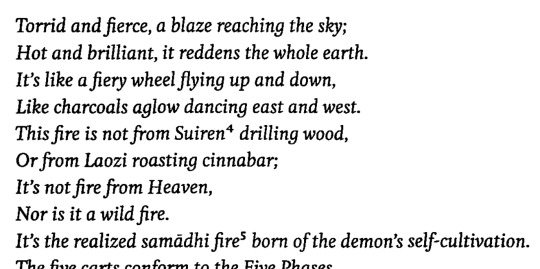
(Wu & Yu, 2012, vol. 2, p. 225)
The general concept of Samādhi (Sk: "concentration"; Ch: sanmei, 三昧) refers to an advanced level of meditation where one can "establish and maintain one-pointedness of mind on a specific object of concentration" (Buswell & Lopez, 2014, p. 743). Some Hindu and Buddhist sources associate it with a spiritually cleansing flame. One example comes from the Gaṇḍavyūha section of the Avataṃsaka Sūtra (Ch: Dafang guangfo huayan jing, 大方廣佛華嚴經; compiled by the 3rd or 4th-century CE).
Sudhana (Ch: Shancai tongzi, 善財童子; i.e. Red Boy), the holy work's protagonist, seeks out 53 teachers in the course of his spiritual cultivation. His ninth instructor, a learned Brahmin named Jayoṣmāyatana (Ch: Shengre poluomen, 勝熱婆羅門; lit: "Victorious Heat Brahmin") is said to have achieved "the light of the concentration [i.e. Samādhi] of adamantine flame" (jingang yan sanmei guangming, 金剛焰三昧光明) (Clearly, 1993, p. 1218). The fire that he produces is so powerful that it scares even the gods and demons. Though, the point of the flames appears to be incineration of the ego and desires and illumination of the mind. Sudhana follows his instructions by throwing himself into the fire, thus gaining a higher level of spiritual knowledge.
Here is a translation of that section of the sutra (warning: it is wordy):
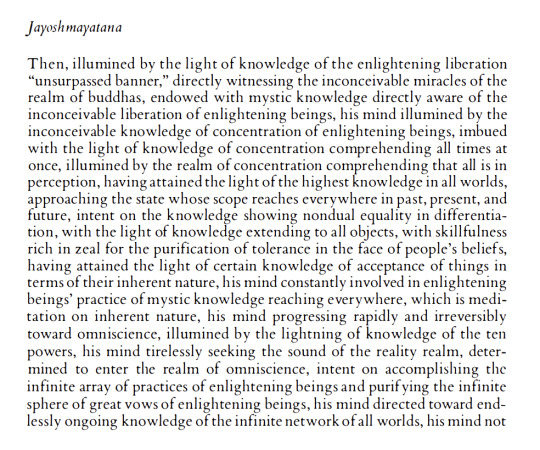

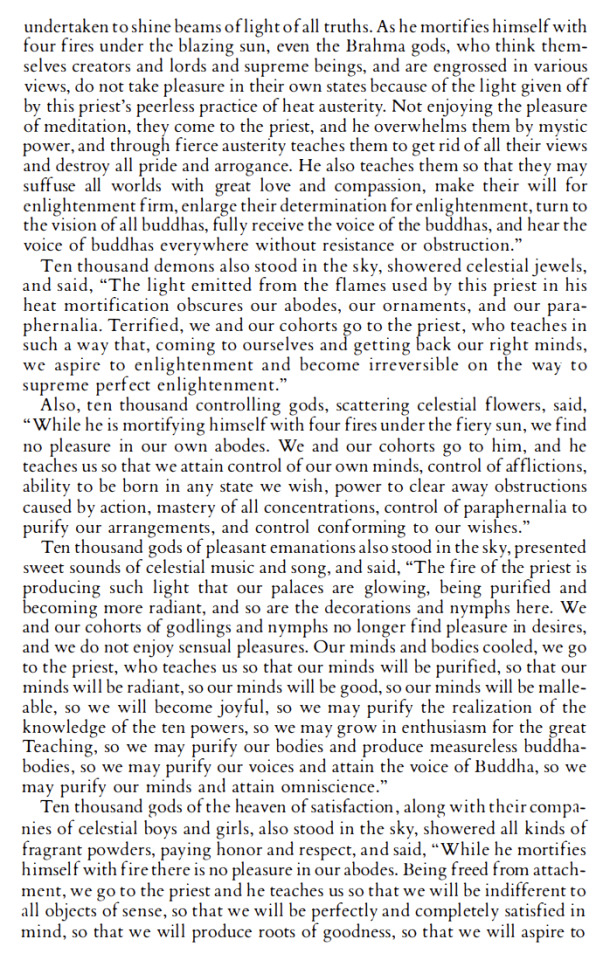
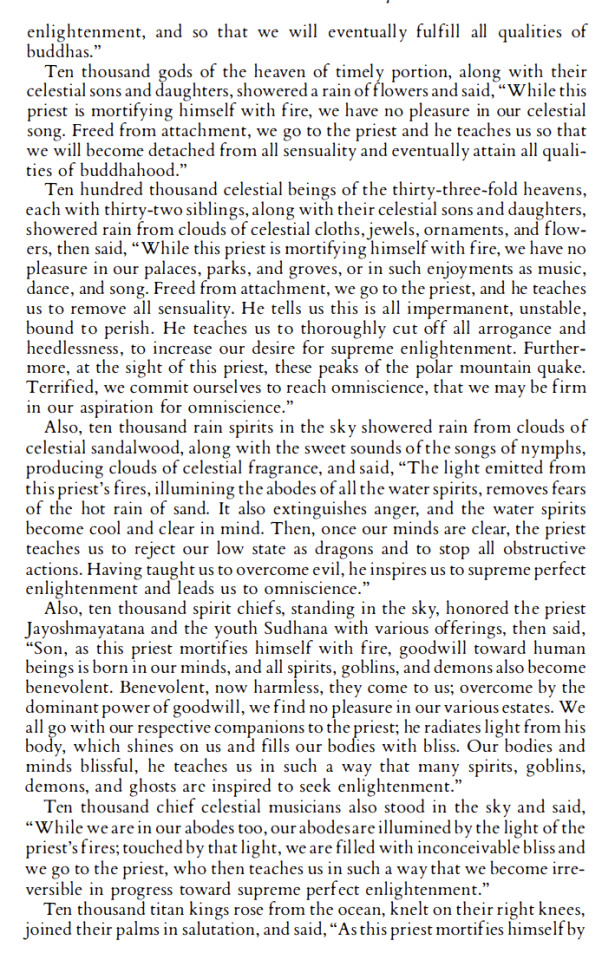
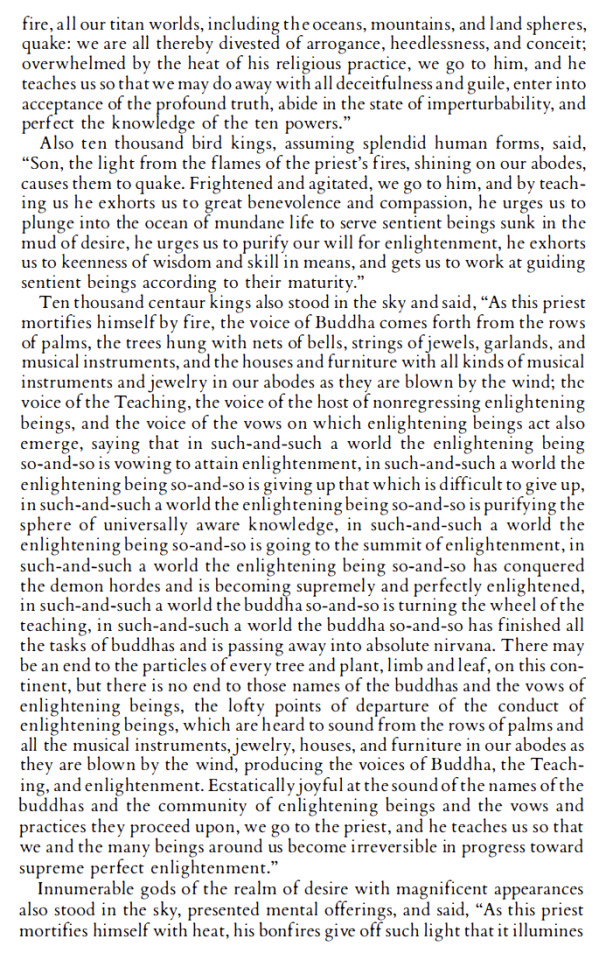
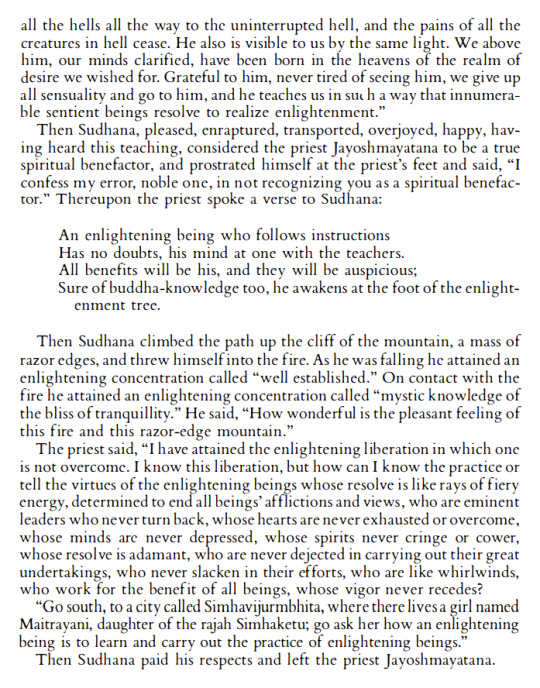
(Clearly, 1993, pp. 1217-1222)
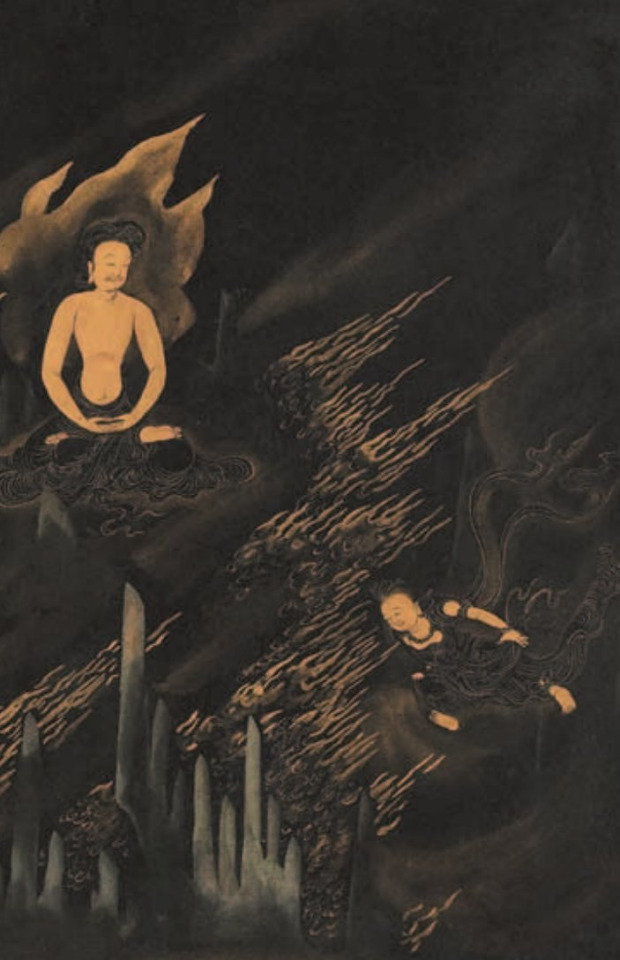
A Song or Ming-era Japanese painting of the fire brahmin and Sudhana.
Sources:
Buswell, R. E. , & Lopez, D. S. (2014). The Princeton Dictionary of Buddhism. Princeton University Press.
Cleary, T. (1993). The Flower Ornament Scripture: A Translation of the Avatamsaka Sutra. Boston: Shambhala.
Wu, C., & Yu, A. C. (2012). The Journey to the West (Vols. 1-4) (Rev. ed.). Chicago, Illinois: University of Chicago Press.
#Samadhi fire#Samadhi flame#Red Boy#Red Son#Journey to the West#JTTW#Buddhism#Hinduism#Samadhi#Lego Monkie Kid#Sudhana#Shancai tongzi#Chinese religion#Indian religion#meditation
97 notes
·
View notes
Text
The Key to the Secret of the Heart Sutra (Hannya shingyō hiken, T. 2203A), translated by Matthew D. McMullen
The Key to the Secret of the Heart Sutra (Hannya shingyō hiken, T. 2203A), translated by Matthew D. McMullen, is a commentary on the Heart Sutra of the Great Perfection of Wisdom (Mahāprajñā – pāramitā-hṛdaya-sūtra). Composed by Kūkai (774–835), the revered founder of the Japanese Shingon school and patriarch of Japanese esoteric Buddhism, this brief commentary purports to reveal the underlying secret meaning to the Heart Sutra and functions as an introduction to Kūkai’s view of mantra as well as a polemical comparison of his Shingon school with the dominant Buddhist schools in Japan at the time.
https://www.bdkamerica.org/product/the-diamond-needle-treatise-on-the-doctrinal-distinctions-of-the-huayan-one-vehicle-the-key-to-the-secret-of-the-heart-sutra/
2 notes
·
View notes
Text
Longmen Grottoes
Longmen Grottoes (World Cultural Heritage, China AAAAA-level tourist attraction)
The Longmen Grottoes are the treasure house of stone carving art with the largest number of statues and the largest scale in the world. It has been rated as "the highest peak of Chinese stone carving art" by UNESCO and ranks first among the major grottoes in China. Unit, AAAAA-level tourist attraction. (14 main attractions)
The grottoes in the Longmen area were first excavated in the Northern Wei Dynasty, flourished in the Tang Dynasty, and finally in the late Qing Dynasty. After more than 10 dynasties, including Northern Wei, Eastern Wei, Western Wei, Northern Qi, Sui, Tang, Five Dynasties, Song, Ming, and Qing Dynasties, it has been built for more than 1,400 years. It is the longest grotto in the world. Among all the caves in Longmen, about 30% of the caves in the Northern Wei Dynasty, 60% in the Tang Dynasty, and only about 10% in other dynasties.
After research, it was found that the Longmen Grottoes were built by Tianzhu (now India), Silla (now South Korea), Tocharo (Siberia), Kanguo (Central Asia) and other countries, and now they have found Western musical instruments, European patterns, ancient Greek stone pillars, etc. The extraterritorial elements are the product of the fusion of diverse civilizations such as Greece, Persia, India and China, and can be called the most internationalized grotto in the world.
Geographical environment
The Longmen Grottoes are located in the southern suburb of Luoyang, the ancient capital. The two mountains face each other, the Yishui River flows, the Foguang Mountains are beautiful, and the scenery is beautiful.
Longmen, also known as Yique, is where the east and west mountains face each other, and the Yihe River flows through it. From afar, it looks like a natural gate, so it was called "Yique" in ancient times.

Longmen Landscape

Longmen Yique
Statue of the Locanabuddha

Locanabuddha
Buddha statues: a total of nine bodies. The main Buddha in the middle is the Great Buddha of Lusena, carved by Wu Zetian according to his own appearance and manners. On the right is the eldest disciple Kasyapa, on the left is the younger disciple Ananda, and then is Samantabhadra Bodhisattva (left) and Manjusri Bodhisattva (right). The heroic and vigorous king, the aggressive warrior and the master Flushena together constitute a group of artistic group images with rich modal texture.
Lord Buddha: Locanabuddha is the Sambhogakaya Buddha, which means the light shines all over the place. The height is 17.14 meters, the head is 4 meters high, and the ears are 1.9 meters long. It is famous for its mysterious smile and is praised as "Oriental Mona Lisa" and "the most beautiful statue in the world" by foreign tourists. The Buddha statue has a plump and round face, wavy hair lines on the top of the head, eyebrows curved like a crescent moon, with a pair of beautiful eyes gazing down slightly, showing a peaceful smile, like a wise and kind middle-aged woman, which is respectable and not afraid.
Samantabhadra Bodhisattva, the free translation of Sanskrit Samantabhadra, has also been translated as Banji Bodhisattva, and transliterated as Sanmando Bhadra. Samantabhadra Bodhisattva is one of the four bodhisattvas of Chinese Buddhism. It symbolizes virtue and conduct, and corresponds to Manjushri, who symbolizes wisdom and virtue. He is also the left and right attendant of Sakyamuni Buddha. In addition, Vairocana Tathagata, Manjushri Bodhisattva, and Samantabhadra Bodhisattva are honored as the "Three Saints of Huayan".

On the left is the "Tang Dynasty After the Journey" drawn by Zhang Xuan in the Tang Dynasty. Wu Zetian carved the Lushena Buddha in the Longmen Grottoes according to his own appearance.

Binyang South Cave

Lotus Cave
Value influence: The lotus dome of the Great Hall of the People is designed based on this lotus.
The smallest Buddha statue in the Longmen Grottoes is only 2 centimeters high. These small thousand Buddhas are located above the south wall of the Lianhua Cave, which are vivid, detailed and lifelike.

Xiangshan Temple

Digital restoration
2 notes
·
View notes
Quote
Any account of Cleary’s translations must commence with his monumental rendition of the Avatamsaka (Flower Ornament) Sutra, more than 1600 pages, one of the most stimulating of Mahayana texts. It is replete with luminous visions of bodhisattva activity and exalted experiences of mind and reality, conveyed with lush, psychedelic, evocative imagery. As the inspiration for the Chinese Huayan teachings (Kegon in Japanese) it is highly influential for all East Asian Buddhism. In his Huayan class I attended, Cleary mentioned that he recited aloud the entire Avatamsaka Sutra in Chinese seven times before he started translating it. Cleary’s Entry into the Inconceivable is one of the most valuable books on the dialectical Huayan philosophy, providing translations of the dense, profound writings from the Chinese Huayan founders. As with most of his translations, Cleary’s introductory commentaries are extremely informative.
In Appreciation of Thomas Cleary: A Personal Remembrance | Sangha News Journal
0 notes
Text
The Key to the Secret of the Heart Sutra (Hannya shingyō hiken, T. 2203A), The Key to the Secret of the Heart Sutra (Hannya shingyō hiken, T. 2203A), translated by Matthew D. McMullen, is a commentary on the Heart Sutra of the Great Perfection of Wisdom (Mahāprajñā – pāramitā-hṛdaya-sūtra). Composed by Kūkai (774–835), the revered founder of the Japanese Shingon school and patriarch of Japanese esoteric Buddhism, this brief commentary purports to reveal the underlying secret meaning to the Heart Sutra and functions as an introduction to Kūkai’s view of mantra as well as a polemical comparison of his Shingon school with the dominant Buddhist schools in Japan at the time.translated by Matthew D. McMullen
The Diamond Needle, Treatise on the Doctrinal Distinctions of the Huayan One Vehicle, The Key to the Secret of the Heart Sutra – BDK America
1 note
·
View note
Text
Teachings in Chinese Buddhism
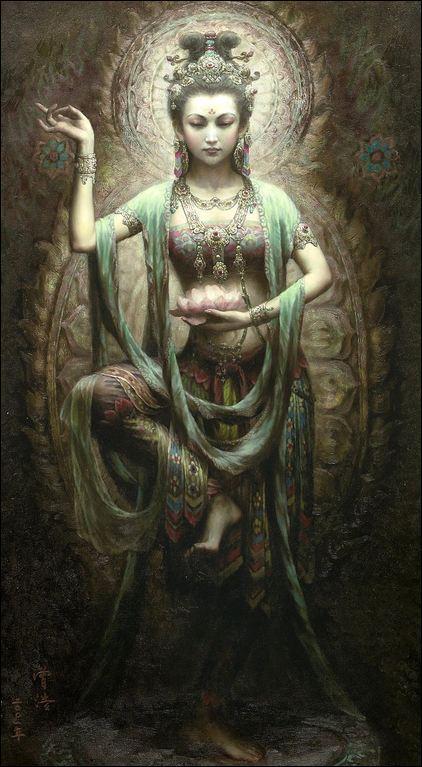

Teachings in Chinese Buddhism
Teachings in Chinese Buddhism is a collection of selected and translated articles from five books in the Third volume of the Chinese Miao Yun Collection; namely “The Dharma is the Saver of the World”, “The Three Essentials in Practicing the Teaching of the Buddha”, “The Buddha lives in the world”, “To investigate the Dharma according to the Teachings of the Buddha” and “My view on Religions”. These texts are from the Mahayana tradition as it is practiced traditionally in China. Download the free ebook here (257 pages):

Teachings in Chinese Buddhism
What is Chinese Buddhism?
Buddhism in China presents a journey of continuous evolution, cultural assimilation, and spiritual ideology that dates back to the first century CE. Chinese Buddhism, a constituent of East Asian Buddhism, has played a crucial role in shaping the country's philosophy, arts, politics, and sociology. Through numerous transformations and reinterpretations over the centuries, it has woven itself into the fabric of Chinese culture and has significantly contributed to the spiritual lives of millions.
Chinese Buddhism originated from the Indian subcontinent, the birthplace of Buddhism. Its introduction to China is largely attributed to the bustling interaction along the Silk Road, a network of trade routes that linked the East and West, facilitating not just the exchange of goods, but also culture, religion, and philosophy.
The earliest documented transmission of Buddhism to China is during the Han dynasty, with references to Buddhist monks and translated sutras appearing in Chinese historical records. These early transmissions laid the groundwork for a more profound proliferation of Buddhist ideology throughout the nation, which would take place in subsequent dynasties.
The Flowering of Schools and Philosophical Developments
The efflorescence of Buddhist thought in China led to the establishment of various schools, each interpreting the teachings of Buddha through different philosophical lenses. Among these, Chán (Zen in Japanese), Pure Land, Tiantai, and Huayan became highly influential.
1. Chán Buddhism: Known for its emphasis on meditative practice and enlightenment, Chán Buddhism uniquely adapted Buddhist principles with ancient Chinese thought, including Daoism and Confucianism. This school emphasizes direct insight gained through meditation and interaction between masters and students, famously illustrated through enigmatic dialogues known as "koans."
2. Pure Land Buddhism: Centered around the belief in the Western Paradise, or "Pure Land," of Amitābha Buddha, this devotional sect emphasizes faith and chanting practices as a path to rebirth in this realm of awakening. Its accessibility and simple practices contributed to its widespread popularity among both monastic and lay practitioners.
3. Tiantai: Based on the Lotus Sutra's teachings, the Tiantai school promoted the perspective of the inherent enlightenment of all beings and the concept of the "One Vehicle," which integrates all diverse Buddhist teachings into a single, coherent system.
4. Huayan: Drawing deeply from the Avataṃsaka Sūtra, this school is known for its profound and intricate philosophy, emphasizing the interpenetration of all phenomena and the notion that one contains all, in a vision of the universe as a perfect and harmonious totality.
Cultural Integration and Syncretism
Chinese Buddhism never existed in isolation. Instead, it engaged in a complex process of adaptation and transformation, blending seamlessly with the pre-existing Confucian and Daoist traditions. Temples often housed shrines dedicated to figures from different traditions, while Buddhist precepts influenced Chinese literature, art, and imperial policy.
In art, Buddhist influence manifested in various forms, from the majestic Giant Buddha statues carved into cliffs to the intricate paintings and sculptures depicting various Buddhas, bodhisattvas, and deities, illustrating the rich cosmology of Buddhist belief. Moreover, Buddhist festivals became part of the community's cultural life, integrating rituals, food, and customs that solidified the religion's role within the societal framework.
Challenges, Resurgence, and Contemporary Practice
Like many spiritual traditions, Buddhism in China has faced challenges, including periods of imperial suppression, most notably during the Tang dynasty, and severe restrictions and destruction during the Cultural Revolution of the 20th century. However, the post-Mao era has seen a revival, with monasteries being restored and a growing interest among Chinese people in Buddhist philosophy and meditation, reflecting the universal themes of suffering, liberation, and compassion.
In the contemporary era, Chinese Buddhism negotiates its place among rapid modernization and globalization. Monastics and lay practitioners are harnessing technology and modern communication to disseminate teachings, while engaging in social causes such as charity, environmental conservation, and cultural preservation, thereby reinterpreting the application of the Buddha's teachings in the context of contemporary societal issues.
Chinese Buddhism, with its intricate history, broad philosophical dimensions, and profound cultural impact, remains an integral component of China's spiritual heritage. As it continues to evolve and adapt to the rhythms of modern society, it offers enduring insights and practices aimed at understanding the human condition, fostering a harmonious existence with the world, and attaining spiritual liberation. Beyond merely a religion, Chinese Buddhism represents a perennial flow of wisdom and compassion through the heart of Chinese civilization.
Read the full article
1 note
·
View note
Text
Dharmic & Indian Hinduism
Dharmic & Indian
Hinduism
Organized by religious ideologies, movements, ethnic groups & geography.
Shaivism
-Aghori -Tantra
Shaktism
-Tantra
-Yellamma sect
Smartism
Vaishnavism
-Gaudiya (ISKCON)
-Swaminarayan
-Tantra
Vedic (ancient Indian)
-Mimamsa
-Samkhya
Other: Charvaka,Mahima Dharma,Ramakrishna Mission
People: Dalit, Ramnami
Countries: Bali, Canada, Cham (Vietnam), Ghana, India, Sri Lanka, South Africa, Thailand, United Arab Emirates, United Kingdom, United States
Buddhism
Organized by schools of thought.
Mahayana
-Huayan School
-Jodo Shinshu
-Nichiren Buddhism
-Nyingma School
-Pure Land Buddhism
-Sakya School
-Tendai/Tiantai Buddhism
-Tibetan Buddhism
-True Buddha School
Theravada
Vajrayana
-Hoa Hao (lay Buddhism)
-Humanistic Buddhism (Fo Guang Shan)
-Tantra
-Tibetan Buddhism
-Zen/Chan Buddhism (Japanese/Chinese)
Jainism
Digambara
Svetambara
Sikhi (Sikhism)
Akhand Kirtani Jatha
Brahm Bunga (Dodra)
Dam Dami Taksal
Nihang
-Budha Dal
-Tarna Dal
Other: Kes Dhari, Namdhari, Sahaj Dari, Sikh Dharma International,Udasi
Others
Ayyavazhi
Meivazhi
Sanamahism
1 note
·
View note
Text
This matter of relationship is extremely important, and perhaps the most important difference between the Hua-yen view of things and the ordinary view is that people ordinarily think and experience in terms of distinct, separate entities, while Hua-yen conceives of experience primarily in terms of the relationships between these same entities. It is simply a question of fundamental, basic reality; is it separate parcels of matter (or mental objects) or is it relationship? It is interesting in this regard to see that a great number of Western physicists have now drawn the conclusion, based on the implication of Einstein’s theories, that relationship is the more fundamental. As one physicist remarked, if all the matter in the universe less one bundle of matter ceased to exist, the mass of the remaining parcel of matter (and hence its existence) would be reduced to nothing, the implication being that mass is a function of total environment and dependent on it. Nonetheless, in the seventh century, Fa-tsang and other Hua-yen masters taught that to exist in any sense at all means to exist in dependence on the other, which is infinite in number. Nothing exists truly in and of itself, but requires everything to be what it is.
Francis H. Cook, Hua-yen Buddhism: The Jewel Net of Indra
#emphasis mine#text#quote#francis h cook#hua-yen buddhism#the jewel net of indra#huayan#huayen#huayan buddhism#buddhism#huayen buddhism#physics#science#reality#relation#process philosophy#philosophy#interdependence#identity#relationship#substance#matter#indra#indra's net#dependent arising
36 notes
·
View notes
Quote
The Buddhist allegory of "Indra's Net" tells of an endless net of threads throughout the universe, the horizontal threads running through space, the vertical ones through time. At every crossing of threads is an individual, and every individual is a crystal bead. The great light of "Absolute Being" illuminates and penetrates every crystal bead; moreover, every crystal bead reflects not only the light from every other crystal in the net-but also every reflection of every reflection throughout the universe.
Douglas Hofstadter, Gödel, Escher, Bach: an Eternal Golden Braid
#quote#Buddhism#philosphy#systems#systems theory#Huayan#Douglas Hofstadter#Hofstadter#science#spirituality#universe#Indra's Net
233 notes
·
View notes
Text
“[One example of a Huayan practice] is the “ocean mirror,” or “ocean seal,” samadhi. In this image, awareness is like the vast ocean surface, reflecting and confirming in detail all phenomena of the entire universe. Waves of phenomena may arise on the surface of the ocean, distorting its ability to mirror plainly; but when the waves subside as the water calms and clears, the ocean mirror again reflects all clearly. Our individual minds are like this, often disturbed by turbulence but also capable of settling serenely to reflect clear awareness.”—Taigen Dan Leighton, read the full article here
43 notes
·
View notes
Text
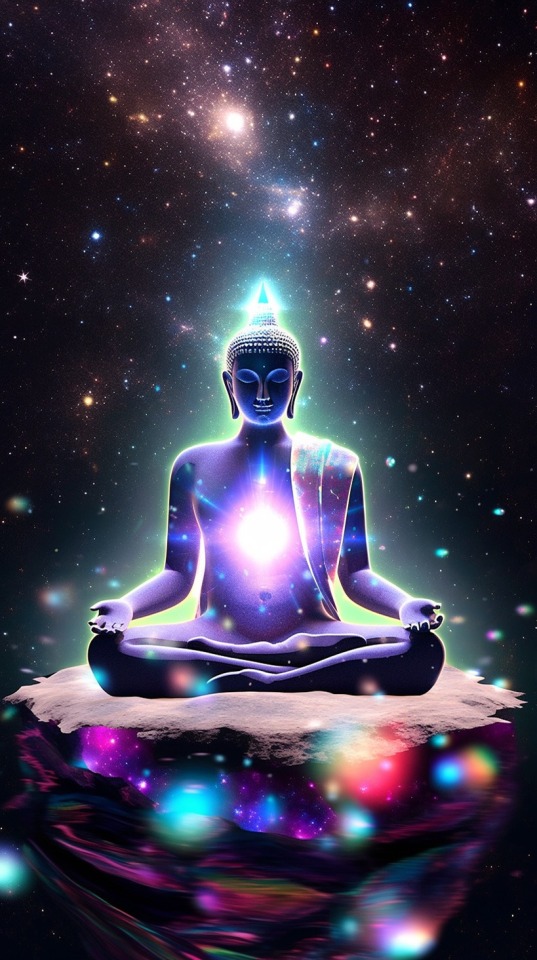

The Avatamsaka Sutra
'Cosmic Buddha'
Talon Abraxas
The Avatamsaka sutra also states that the wisdom of the Buddha (the Tathagata) is present everywhere in the universe, indeed, it is present within every living being. Thus, the sutra states (in chapter 32, Manifestation of the Tathagata): Son of Buddha, the wisdom of Tathagata is present everywhere.
34 notes
·
View notes
Text
1 note
·
View note